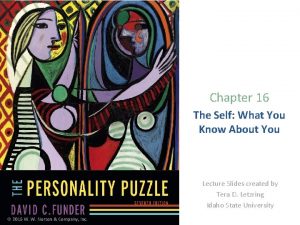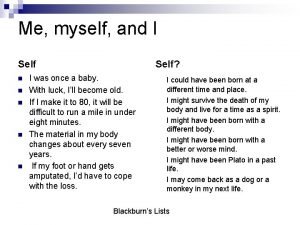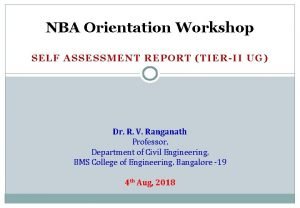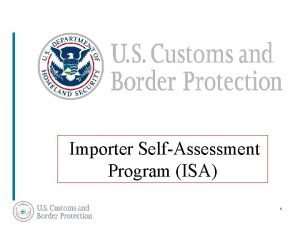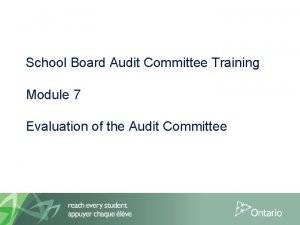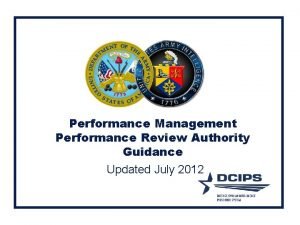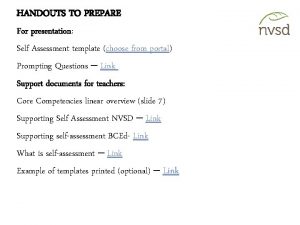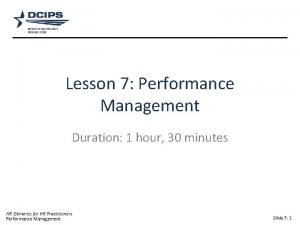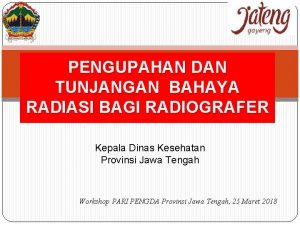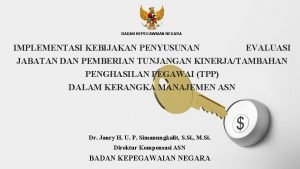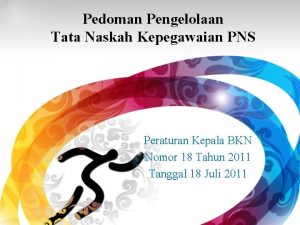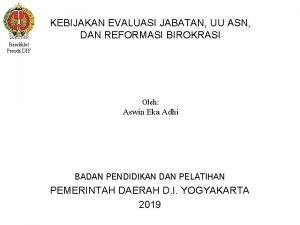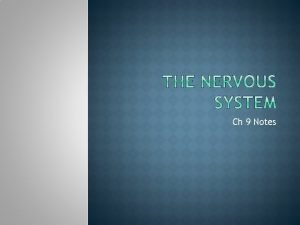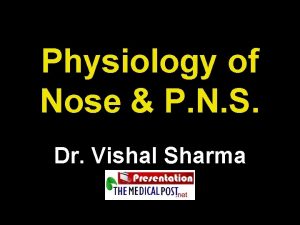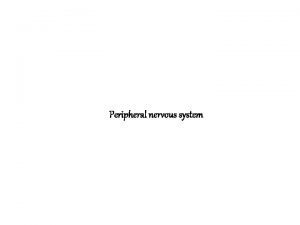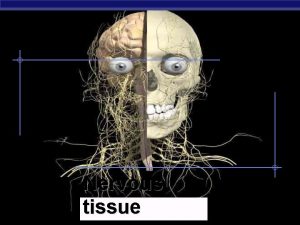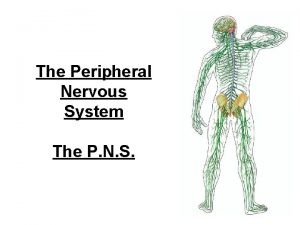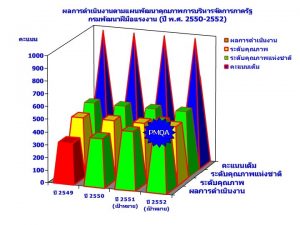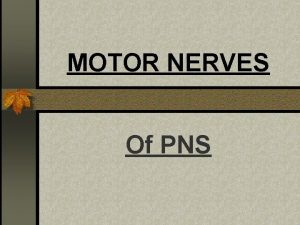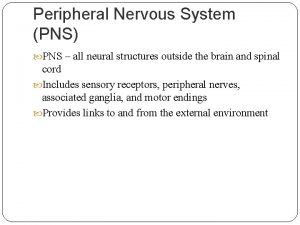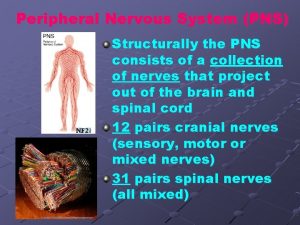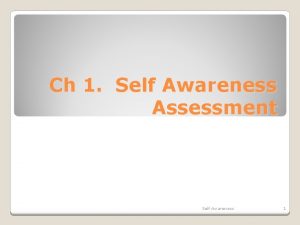Self Assessment Chapter 13 Overview of the PNS







































































































































- Slides: 135

Self Assessment Chapter 13

Overview of the PNS • __________ (____) – links CNS to body and to external environment • ____ detects sensory stimuli and delivers information to CNS as sensory input • ___processes input and transmits impulse through PNS to muscle cells and glands as motor output © 2016 Pearson Education, Inc.

Overview of the PNS • Peripheral nervous system (PNS) – links CNS to body and to external environment • PNS detects sensory stimuli and delivers information to CNS as sensory input • CNS processes input and transmits impulse through PNS to muscle cells and glands as motor output © 2016 Pearson Education, Inc.

Divisions of the PNS is classified functionally into 2 divisions: • ______– consists of _______ (_______) neurons that detect and transmit sensory stimuli to CNS; has 2 anatomical subdivisions (Figure 13. 1): • Somatic _______division detects both internal and external stimuli; general sense receptors detect stimuli from skin; special sensory receptors detect stimuli from special sense organs • Visceral ____division relays internal information (like blood pressure) from organs of abdominopelvic and thoracic cavities • ______– consists of ______(______) neurons; carry out motor functions of nervous system; subdivisions based on organs that neurons contact (Figure 13. 1): • Somatic ____division – responsible for voluntary motor functions; composed of lower motor neurons (somatic motor neurons) which directly trigger skeletal muscle contractions • Visceral ____division (autonomic motor nervous system, ANS) – responsible for maintaining many aspects of homeostasis by controlling involuntary motor functions in body; neurons innervate cardiac muscle cells, smooth muscle cells, and secretory cells of glands © 2016 Pearson Education, Inc.

Divisions of the PNS-PNS is classified functionally into 2 divisions: Sensory division – consists of sensory (afferent) neurons that detect and transmit sensory stimuli to CNS; has 2 anatomical subdivisions (Figure 13. 1): • Somatic sensory division detects both internal and external stimuli; general sense receptors detect stimuli from skin; special sensory receptors detect stimuli from special sense organs • Visceral sensory division relays internal information (like blood pressure) from organs of abdominopelvic and thoracic cavities Motor division – consists of motor (efferent) neurons; carry out motor functions of nervous system; subdivisions based on organs that neurons contact (Figure 13. 1): • Somatic motor division – responsible for voluntary motor functions; composed of lower motor neurons (somatic motor neurons) which directly trigger skeletal muscle contractions • Visceral motor division (autonomic motor nervous system, ANS) – responsible for maintaining many aspects of homeostasis by controlling involuntary motor functions in body; neurons innervate cardiac muscle cells, smooth muscle cells, and secretory cells of glands

Overview of Peripheral Nerves and Associated Ganglia • _____– main organs of PNS; consist of axons of many neurons bound together by connective tissue • Nerves of PNS contact or innervate majority of structures in body • _____– contain both sensory and motor neurons • ______– contain only sensory neurons while motor nerves contain mostly motor neurons (also some sensory neurons involved in muscle stretch and tension) © 2016 Pearson Education, Inc.

Overview of Peripheral Nerves and Associated Ganglia • Peripheral nerves – main organs of PNS; consist of axons of many neurons bound together by connective tissue • Nerves of PNS contact or innervate majority of structures in body • Mixed nerves – contain both sensory and motor neurons • Sensory nerves – contain only sensory neurons while motor nerves contain mostly motor neurons (also some sensory neurons involved in muscle stretch and tension) © 2016 Pearson Education, Inc.

Overview of Peripheral Nerves and Associated Ganglia • _______– originate from spinal cord and innervate structures below head and neck; anatomical structures associated with this group of nerves include (Figure 13. 2 a): • Two collections of axons connect PNS with spinal cord’s gray matter; _______root consists of motor neurons from anterior horn and ____root consists of sensory neurons from posterior horn © 2016 Pearson Education, Inc.

Overview of Peripheral Nerves and Associated Ganglia • Spinal nerves – originate from spinal cord and innervate structures below head and neck; anatomical structures associated with this group of nerves include (Figure 13. 2 a): • Two collections of axons connect PNS with spinal cord’s gray matter; anterior root consists of motor neurons from anterior horn and posterior root consists of sensory neurons from posterior horn © 2016 Pearson Education, Inc.

Overview of Peripheral Nerves and Associated Ganglia • Spinal nerves (continued): • Posterior root features a swollen area that houses cell bodies of sensory neurons called ________(or ____root ganglion) • Posterior and anterior roots fuse to form spinal nerve just lateral to posterior root ganglion • All 31 pairs of spinal nerves are _______nerves © 2016 Pearson Education, Inc.

Overview of Peripheral Nerves and Associated Ganglia • Spinal nerves (continued): • Posterior root features a swollen area that houses cell bodies of sensory neurons called posterior root ganglion (or dorsal root ganglion) • Posterior and anterior roots fuse to form spinal nerve just lateral to posterior root ganglion • All 31 pairs of spinal nerves are mixed nerves © 2016 Pearson Education, Inc.

Overview of Peripheral Nerves and Associated Ganglia Figure 13. 2 a The structure of roots©and spinal. Education, nerves. Inc. 2016 Pearson

Overview of Peripheral Nerves and Associated Ganglia • Structures associated with spinal nerves (Figure 13. 2 bc): • ______– outermost layer of connective tissue that holds motor and sensory axons together • _____– small groups of bundled axons surrounded by connective tissue called _______ • Each individual axon within a fascicle is surrounded by its own connective tissue called _______ © 2016 Pearson Education, Inc.

Overview of Peripheral Nerves and Associated Ganglia • Structures associated with spinal nerves (Figure 13. 2 bc): • Epineurium – outermost layer of connective tissue that holds motor and sensory axons together • Fascicles – small groups of bundled axons surrounded by connective tissue called perineurium • Each individual axon within a fascicle is surrounded by its own connective tissue called endoneurium © 2016 Pearson Education, Inc.

Overview of Peripheral Nerves and Associated Ganglia Figure 13. 2 bc The structure of roots and. Pearson spinal nerves. © 2016 Education, Inc.

• _______– attach to brain and mostly innervate structures in head and neck; not formed by fusion of sensory and motor roots (like spinal nerves); allows for purely sensory, mixed, and mostly motor nerves © 2016 Pearson Education, Inc.

Overview of Peripheral Nerves and Associated Ganglia • Cranial nerves – attach to brain and mostly innervate structures in head and neck; not formed by fusion of sensory and motor roots (like spinal nerves); allows for purely sensory, mixed, and mostly motor nerves © 2016 Pearson Education, Inc.

Functional Overview of the PNS Functions of PNS are integrated with those of CNS: • Sensory neurons detect stimuli at sensory receptors after which the following events occur: • Detected stimuli are transmitted along sensory neuron (spinal or cranial) to cerebral cortex • In cortex, sensory information is interpreted, integrated, and an appropriate motor response is selected and initiated (next slide) © 2016 Pearson Education, Inc.

Functional Overview of the PNS • Motor response is initiated by commands from motor areas of cerebral cortex, leads to following events: • Impulses travel to spinal cord where neurons synapse with lower motor neurons of PNS • Lower motor neurons carry impulses to appropriate muscles via cranial or spinal nerves where they trigger contractions © 2016 Pearson Education, Inc.

The Sensory Cranial Nerves • Three cranial nerves contain axons of only sensory neurons: • ___________ • ______ © 2016 Pearson Education, Inc.

The Sensory Cranial Nerves • Three cranial nerves contain axons of only sensory neurons: • Olfactory (I) • Optic (II) • Vestibulocochlear (VIII) • See Table 13. 1 for location and function of these nerves © 2016 Pearson Education, Inc.

The Sensory Cranial Nerves Table 13. 1 The Sensory Cranial Nerves. © 2016 Pearson Education, Inc.

The Motor Cranial Nerves • Five cranial nerves contain primarily axons of motor neurons with their associated sensory axons responsible for proprioception: • _____________ • _______ • See Table 13. 2 for location and function of these nerves © 2016 Pearson Education, Inc.

The Motor Cranial Nerves • Five cranial nerves contain primarily axons of motor neurons with their associated sensory axons responsible for proprioception: • Oculomotor (III) • Trochlear (IV) • Abducens (VI) • Accessory (XI) • Hypoglossal (XII) • See Table 13. 2 for location and function of these nerves © 2016 Pearson Education, Inc.

The Motor Cranial Nerves Table 13. 2 The Motor Cranial Nerves. © 2016 Pearson Education, Inc.

The Motor Cranial Nerves Table 13. 2 The Motor Cranial Nerves. © 2016 Pearson Education, Inc.

The Mixed Cranial Nerves • Four cranial nerves contain axons of both sensory and motor neurons: • • _____________ • See Table 13. 3 for location and function of these nerves © 2016 Pearson Education, Inc.

The Mixed Cranial Nerves • Four cranial nerves contain axons of both sensory and motor neurons: • • Trigeminal (V) Facial (VII) Glossopharyngeal (IX) Vagus (X) • See Table 13. 3 for location and function of these nerves © 2016 Pearson Education, Inc.

The Mixed Cranial Nerves Table 13. 3 The Mixed Cranial Nerves. © 2016 Pearson Education, Inc.

The Mixed Cranial Nerves Table 13. 3 The Mixed Cranial Nerves. © 2016 Pearson Education, Inc.

The Mixed Cranial Nerves Table 13. 3 The Mixed Cranial Nerves. © 2016 Pearson Education, Inc.

Overview of Cranial Nerves Figure 13. 3 Overview of cranial nerves. © 2016 Pearson Education, Inc.

Study Boost: Remembering the Cranial Nerves Popular mnemonic to remember cranial nerves: • Oh (I, Olfactory) Once (II, Optic) One (III, Oculomotor) Takes (IV, Trochlear) The (V, Trigeminal) Anatomy (VI, Abducens) Final (VII, Facial) Very (VIII, Vestibulocochlear) Good (IX, Glossopharyngeal) Vacations (X, Vagus) Are (XI, Accessory) Happening (XII, Hypoglossal) • Remember that you have one nose (I, olfactory) and two eyes (II, optic) © 2016 Pearson Education, Inc.

Study Boost: Remembering the Cranial Nerves Popular mnemonic cranial nerves by their main function: • Some (I, Olfactory—Sensory) Say (II, Optic—Sensory) Money (III, Oculomotor—Motor) Matters (IV, Trochlear— Motor) But (V, Trigeminal—Both) My (VI, Abducens— Motor) Brother (VII, Facial—Both) Says (VIII, Vestibulocochlear—Sensory) Big (IX, Glossopharyngeal— Both) Brains (X, Vagus—Both) Matter (XI, Accessory— Motor) More (XII, Hypoglossal—Motor) • Look closely at names and connect them with word roots (see back of book); for example, oculomotor, broken into its two components, oculo-, which means “eye, ” and -motor, which means “movement” © 2016 Pearson Education, Inc.

• _______ – short and divides into following 2 mixed nerves; both carry both somatic motor and sensory information (Figure 13. 4): • _____ramus – travels to posterior side of body • _____ramus – travels to anterior side of body and/or to an upper or lower limb © 2016 Pearson Education, Inc.

Structure of Spinal Nerves and Spinal Nerve Plexuses • Spinal nerve – short and divides into following 2 mixed nerves; both carry both somatic motor and sensory information (Figure 13. 4): • Posterior ramus – travels to posterior side of body • Anterior ramus – travels to anterior side of body and/or to an upper or lower limb © 2016 Pearson Education, Inc.

Structure of Spinal Nerves and Spinal Nerve Plexuses Figure 13. 4 a Structure and function of roots, spinal nerves, and rami. © 2016 Pearson Education, Inc.

Structure of Spinal Nerves and Spinal Nerve Plexuses Figure 13. 4 b Structure and function of roots, spinal nerves, and rami. © 2016 Pearson Education, Inc.

Structure of Spinal Nerves and Spinal Nerve Plexuses • __pairs of spinal nerves (Figure 13. 5): • • __ pairs of cervical nerves __pairs of thoracic nerves __pairs of lumbar and sacral nerves __pair of coccygeal nerves • _______rami of cervical, lumbar, and sacral spinal nerves each merge to form complicated networks of nerves called nerve plexuses © 2016 Pearson Education, Inc.

Structure of Spinal Nerves and Spinal Nerve Plexuses • 31 pairs of spinal nerves (Figure 13. 5): • • 8 pairs of cervical nerves 12 pairs of thoracic nerves 5 pairs of lumbar and sacral nerves 1 pair of coccygeal nerves • Anterior rami of cervical, lumbar, and sacral spinal nerves each merge to form complicated networks of nerves called nerve plexuses © 2016 Pearson Education, Inc.

Structure of Spinal Nerves and Spinal Nerve Plexuses Figure 13. 5 Overview of spinal nerves. © 2016 Pearson Education, Inc.

Right and left ____plexuses are found deep in neck lateral to 1 st through 4 th cervical vertebrae (Figure 13. 6) • Plexus consists of anterior rami of _____ and a small contribution from hypoglossal nerve (cranial nerve XII) • Each nerve in plexus has cutaneous branches; innervate skin of neck and sections of head, chest, and shoulders • Motor branches of these nerves innervate specific muscles in neck • _____– major motor branch of C 4 with contributions from C 3 and C 5 (3 -4 -5 to stay alive); innervates diaphragm © 2016 Pearson Education, Inc.

Cervical Plexuses Right and left cervical plexuses are found deep in neck lateral to 1 st through 4 th cervical vertebrae (Figure 13. 6) • Plexus consists of anterior rami of C 1–C 5 and a small contribution from hypoglossal nerve (cranial nerve XII) • Each nerve in plexus has cutaneous branches; innervate skin of neck and sections of head, chest, and shoulders • Motor branches of these nerves innervate specific muscles in neck • Phrenic nerve – major motor branch of C 4 with contributions from C 3 and C 5 (3 -4 -5 to stay alive); innervates diaphragm © 2016 Pearson Education, Inc.

Cervical Plexuses Figure 13. 6 The cervical plexus. © 2016 Pearson Education, Inc.

Right and left ______plexuses – lateral to 5 th cervical through 1 st thoracic vertebrae; provide motor and sensory innervation to _________ includes nerve roots from C 1–T 1 (Figure 13. 7) • Brachial plexus begins with formation of large nerve trunks • C 5 and C 6 typically unite to form superior trunk • C 7 usually forms the middle trunk • C 8 and T 1 usually unite to form the inferior trunk © 2016 Pearson Education, Inc.

Brachial Plexuses Right and left brachial plexuses – lateral to 5 th cervical through 1 st thoracic vertebrae; provide motor and sensory innervation to upper limbs; includes nerve roots from C 5–T 1 (Figure 13. 7) • Brachial plexus begins with formation of large nerve trunks • C 5 and C 6 typically unite to form superior trunk • C 7 usually forms the middle trunk • C 8 and T 1 usually unite to form the inferior trunk © 2016 Pearson Education, Inc.

Brachial Plexuses © 2016 Pearson Education, Inc.

Brachial Plexuses • Each trunk splits into an anterior and a posterior division; become cords of plexus (Figure 13. 7 a) • Anterior division of inferior trunk forms medial cord that descends down medial arm • Anterior divisions of superior and middle trunks combine to form lateral cord, which descends down lateral arm • Posterior divisions of each trunk unite to form posterior cord, which lies in posterior arm © 2016 Pearson Education, Inc.

Brachial Plexuses Figure 13. 7 a The brachial plexus. © 2016 Pearson Education, Inc.

Brachial Plexuses • Five major nerves of brachial plexus (Figure 13. 7 b): • ____nerve– branch of posterior cord; serves structures near axilla including deltoid and teres minor muscles and skin over deltoid region • ____nerve – continuation of posterior cord as it descends in posterior arm; innervates triceps brachii muscle and most of extensor muscles of forearm; also innervates skin over posterior thumb, 2 nd digit, 3 rd digit, and lateral half of 4 th digit • ______nerve – continuation of lateral cord; innervates anterior arm muscles, including biceps brachii, and skin covering lateral arm • ______nerve – derived from fusion of lateral and medial cords; travels down middle of arm and forearm; innervates wrist and digital flexors, some intrinsic muscles of hand skin over anterior thumb, 2 nd, 3 rd digits, and lateral half of 4 th digit • _____nerve – continuation of medial cord; travels near elbow where it enters forearm to innervate flexor muscles in forearm (not innervated by median nerve), most of intrinsic hand muscles, and skin of 5 th digit and medial side of 4 th digit © 2016 Pearson Education, Inc.

Brachial Plexuses • Five major nerves of brachial plexus (Figure 13. 7 b): • Axillary nerve – branch of posterior cord; serves structures near axilla including deltoid and teres minor muscles and skin over deltoid region • Radial nerve – continuation of posterior cord as it descends in posterior arm; innervates triceps brachii muscle and most of extensor muscles of forearm; also innervates skin over posterior thumb, 2 nd digit, 3 rd digit, and lateral half of 4 th digit • Musculocutaneous nerve – continuation of lateral cord; innervates anterior arm muscles, including biceps brachii, and skin covering lateral arm • Median nerve – derived from fusion of lateral and medial cords; travels down middle of arm and forearm; innervates wrist and digital flexors, some intrinsic muscles of hand skin over anterior thumb, 2 nd, 3 rd digits, and lateral half of 4 th digit • Ulnar nerve – continuation of medial cord; travels near elbow where it enters forearm to innervate flexor muscles in forearm (not innervated by median nerve), most of intrinsic hand muscles, and skin of 5 th digit and medial side of 4 th digit © 2016 Pearson Education, Inc.

Brachial Plexuses Figure 13. 7 b The brachial plexus. © 2016 Pearson Education, Inc.

Thoracic Spinal Nerves Thoracic spinal nerves do not form plexuses, except ______ • Each posterior ramus innervates deep back muscles • Each anterior ramus travels between two ribs as an ____nerve © 2016 Pearson Education, Inc.

Thoracic Spinal Nerves Thoracic spinal nerves do not form plexuses, except T 1 • Each posterior ramus innervates deep back muscles • Each anterior ramus travels between two ribs as an intercostal nerve © 2016 Pearson Education, Inc.

Left and right _______plexuses are derived from anterior rami of L 1–L 5; anterior to vertebrae; embedded deep within ______ muscle; branches innervate ______and _____after splitting into 2 divisions Figure 13. 8 a The lumbar plexus. © 2016 Pearson Education, Inc.

Lumbar Plexuses Left and right lumbar plexuses are derived from anterior rami of L 1–L 4; anterior to vertebrae; embedded deep within psoas muscle; branches innervate pelvic structures and lower extremity after splitting into 2 divisions Figure 13. 8 a The lumbar plexus. © 2016 Pearson Education, Inc.

Lumbar Plexuses • Lumbar plexus divisions: • ____nerve – anterior division’s largest member • Enters thigh from pelvis via obturator foramen • Branches of nerve innervate adductor muscles in thigh, hip joint, and skin over medial aspect of thigh © 2016 Pearson Education, Inc.

Lumbar Plexuses • Lumbar plexus divisions: • Obturator nerve – anterior division’s largest member • Enters thigh from pelvis via obturator foramen • Branches of nerve innervate adductor muscles in thigh, hip joint, and skin over medial aspect of thigh © 2016 Pearson Education, Inc.

Lumbar Plexuses • Lumbar plexus divisions (continued): • _____nerve • Posterior division’s largest member; largest branch of lumbar plexus • Travels from psoas, through pelvis and under inguinal ligament to enter thigh where it innervates: anterior thigh muscles and skin over anterior and medial thigh and leg, as well as knee joint © 2016 Pearson Education, Inc.

Lumbar Plexuses • Lumbar plexus divisions (continued): • Femoral nerve • Posterior division’s largest member; largest branch of lumbar plexus • Travels from psoas, through pelvis and under inguinal ligament to enter thigh where it innervates: anterior thigh muscles and skin over anterior and medial thigh and leg, as well as knee joint © 2016 Pearson Education, Inc.

Lumbar Plexuses Figure 13. 8 b The lumbar plexus. © 2016 Pearson Education, Inc.

Sacral Plexuses Right and left sacral plexuses are formed from anterior rami of spinal nerves ____; nerve branches innervate structures of _____, ______region, and much of _____; each plexus is divided into anterior and posterior divisions (Figure 13. 9) © 2016 Pearson Education, Inc.

Sacral Plexuses Right and left sacral plexuses are formed from anterior rami of spinal nerves L 4–S 4; nerve branches innervate structures of pelvis, gluteal region, and much of lower extremity; each plexus is divided into anterior and posterior divisions (Figure 13. 9) © 2016 Pearson Education, Inc.

Sacral Plexuses Figure 13. 9 a The sacral plexus. © 2016 Pearson Education, Inc.

Sacral Plexuses • Sacral plexus divisions: • ____nerve – longest and largest nerve in body; contains axons from both anterior and posterior divisions of sacral plexus (Figure 13. 9 a) • Travels through greater sciatic notch in pelvis into thigh, passing between greater trochanter and ischial tuberosity • Innervates hip joint in posterior thigh before it divides into tibial and common fibular nerves © 2016 Pearson Education, Inc.

Sacral Plexuses • Sacral plexus divisions: • Sciatic nerve – longest and largest nerve in body; contains axons from both anterior and posterior divisions of sacral plexus (Figure 13. 9 a) • Travels through greater sciatic notch in pelvis into thigh, passing between greater trochanter and ischial tuberosity • Innervates hip joint in posterior thigh before it divides into tibial and common fibular nerves © 2016 Pearson Education, Inc.

Sacral Plexuses • Sacral plexus divisions (continued): • _______nerve – larger branch of sciatic nerve; contains axons from anterior division of sacral plexus (Figure 13. 9 b) • Branches innervate most of hamstring muscles as nerve descends distally • Innervates parts of knee and ankle joints as well as plantar flexor muscles such as gastrocnemius • Smaller nerve branches serve posterior and lateral skin of leg as well as skin and muscles of foot © 2016 Pearson Education, Inc.

Sacral Plexuses • Sacral plexus divisions (continued): • Tibial nerve – larger branch of sciatic nerve; contains axons from anterior division of sacral plexus (Figure 13. 9 b) • Branches innervate most of hamstring muscles as nerve descends distally • Innervates parts of knee and ankle joints as well as plantar flexor muscles such as gastrocnemius • Smaller nerve branches serve posterior and lateral skin of leg as well as skin and muscles of foot © 2016 Pearson Education, Inc.

Sacral Plexuses • Sacral plexus divisions (continued): • Smaller ________nerve (common peroneal) – made up of axons from posterior division of sacral plexus • Descends along lateral leg to supply part of knee joint and skin of anterior and distal leg • Divides into superficial and deep branches; superficial branch serves lateral leg and dorsum of foot; deep branch supplies ankle dorsiflexors and two muscles on dorsum of foot © 2016 Pearson Education, Inc.

Sacral Plexuses • Sacral plexus divisions (continued): • Smaller common fibular nerve (common peroneal) – made up of axons from posterior division of sacral plexus • Descends along lateral leg to supply part of knee joint and skin of anterior and distal leg • Divides into superficial and deep branches; superficial branch serves lateral leg and dorsum of foot; deep branch supplies ankle dorsiflexors and two muscles on dorsum of foot © 2016 Pearson Education, Inc.

Sacral Plexuses Figure 13. 9 b The sacral plexus. © 2016 Pearson Education, Inc.

Summary of the Distribution of Spinal Nerve Branches Figure 13. 10 a summarizes cutaneous distribution of spinal plexuses, indicating areas of skin from which these nerves carry sensory information Figure 13. 10 a The distribution of spinal nerve branches. © 2016 Pearson Education, Inc.

Summary of the Distribution of Spinal Nerve Branches Figure 13. 10 b illustrates motor distribution of these plexuses, showing to which groups of muscles these nerves carry motor signals Figure 13. 10 b The distribution of spinal nerve branches. © 2016 Pearson Education, Inc.

From PNS to CNS: Sensory Reception and Receptors • Stimuli are first detected by sensory neurons; from that point stimulus is transmitted by sensory neurons to CNS where stimulus is integrated and interpreted by CNS neurons (Figure 13. 11) © 2016 Pearson Education, Inc.

From PNS to CNS: Sensory Reception and Receptors • _______– process where stimulus is converted into an electrical signal (Figure 13. 11): • Ion channels in axolemma are closed stimulus is detected by a sensory receptor sodium ion channels open sodium ions flow into axoplasm temporary depolarization (receptor potential) • If enough sodium ion enters, membrane potential may reach threshold ________________open action potential is propagated along axon toward CNS © 2016 Pearson Education, Inc.

From PNS to CNS: Sensory Reception and Receptors • Sensory transduction – process where stimulus is converted into an electrical signal (Figure 13. 11): • Ion channels in axolemma are closed stimulus is detected by a sensory receptor sodium ion channels open sodium ions flow into axoplasm temporary depolarization (receptor potential) • If enough sodium ion enters, membrane potential may reach threshold voltage-gated sodium ion channels open action potential is propagated along axon toward CNS © 2016 Pearson Education, Inc.

From PNS to CNS: Sensory Reception and Receptors Figure 13. 11 Sensory transduction. © 2016 Pearson Education, Inc.

From PNS to CNS: Sensory Reception and Receptors Figure 13. 11 Sensory transduction. © 2016 Pearson Education, Inc.

From PNS to CNS: Sensory Reception and Receptors Figure 13. 11 Sensory transduction. © 2016 Pearson Education, Inc.

From PNS to CNS: Sensory Reception and Receptors • Sensory transduction (continued): • ______receptors respond rapidly with high intensity to stimuli but stop sending signals after a certain time period (called adaptation); receptors detect initiation of stimuli but ignore ongoing stimuli (ex, looking for your sunglasses but they are on your head) • ______receptors respond to stimuli with constant action potentials that don’t diminish over time (ex, throbbing of your ankle for a week after an injury) © 2016 Pearson Education, Inc.

From PNS to CNS: Sensory Reception and Receptors • Sensory transduction (continued): • Rapidly adapting receptors respond rapidly with high intensity to stimuli but stop sending signals after a certain time period (called adaptation); receptors detect initiation of stimuli but ignore ongoing stimuli • Slowly adapting receptors respond to stimuli with constant action potentials that don’t diminish over time © 2016 Pearson Education, Inc.

Classification of Sensory Receptors • Sensory receptors exist in many forms: • _____ nerve endings are surrounded by specialized supportive cells • _______nerve endings lack supportive cells © 2016 Pearson Education, Inc.

Classification of Sensory Receptors • Sensory receptors exist in many forms: • Encapsulated nerve endings are surrounded by specialized supportive cells • Free nerve endings lack supportive cells © 2016 Pearson Education, Inc.

Classification of Sensory Receptors • Sensory receptors can be sorted into following classifications by location of stimuli they detect: • _______ – usually close to body’s surface; detect stimuli originating from outside body • _______– usually found within body’s interior; detect stimuli originating from within body itself © 2016 Pearson Education, Inc.

Classification of Sensory Receptors • Sensory receptors can be sorted into following classifications by location of stimuli they detect: • Exteroceptors – usually close to body’s surface; detect stimuli originating from outside body • Interoceptors – usually found within body’s interior; detect stimuli originating from within body itself © 2016 Pearson Education, Inc.

Sensory receptors can be classified by type of stimuli that causes them to depolarize and generate a receptor potential: • ______– encapsulated interoceptors or exteroceptors found in musculoskeletal system, skin, and in many other organs; depolarize in response to anything that mechanically deforms tissue where receptors are found; mechanically gated ion channels allow for sensory transduction from vibration, light touch, stretch, and pressure • ______– exteroceptors, most of which are slowly adapting receptors; depolarize in response to temperature changes; separate receptors detect hot and cold • ______– can be either interoceptors or exteroceptors; depolarize in response to binding to specific chemicals (in body fluids or in air); generate a receptor potential as sodium ion channels open • ______– special sensory exteroceptors found only in eye; depolarize in response to light • ______– usually slowly adapting exteroceptors; depolarize in response to noxious stimuli © 2016 Pearson Education, Inc.

Sensory receptors can be classified by type of stimuli that causes them to depolarize and generate a receptor potential: • Mechanoreceptors – encapsulated interoceptors or exteroceptors found in musculoskeletal system, skin, and in many other organs; depolarize in response to anything that mechanically deforms tissue where receptors are found; mechanically gated ion channels allow for sensory transduction from vibration, light touch, stretch, and pressure • Thermoreceptors – exteroceptors, most of which are slowly adapting receptors; depolarize in response to temperature changes; separate receptors detect hot and cold • Chemoreceptors – can be either interoceptors or exteroceptors; depolarize in response to binding to specific chemicals (in body fluids or in air); generate a receptor potential as sodium ion channels open • Photoreceptors – special sensory exteroceptors found only in eye; depolarize in response to light • Nociceptors – usually slowly adapting exteroceptors; depolarize in response to noxious stimuli (Remember: temperatures outside the ranges of hot and cold receptors are detected by nociceptors, which is why very hot or very cold objects feel painful to touch. ) © 2016 Pearson Education, Inc.

Classes of Mechanoreceptors (Figure 13. 12): • ______consist of a slowly adapting nerve ending surrounded by a capsule of Merkel cells • Found in epidermal ridges of integumentary system; primarily in skin of hands (especially fingertips) • Receptor potentials are generated by mechanically gated ion channels • Detect discriminative touch stimuli (object form and texture) • ________(Meissner corpuscles) – in dermal papillae; rapidly adapting tactile exteroceptors; transmit discriminative touch stimuli • _______(bulbous corpuscles) – spindle-shaped receptors found in dermis, hypodermis, and ligaments; slowly adapting receptors respond to stretch and movement • _______(Pacinian corpuscles) – layered onion-shaped appearance; rapidly adapting receptors found deep within dermis; detect high-frequency vibratory and deep pressure stimuli; example of Structure. Function Core Principle • _______– free nerve endings surrounding base of hair follicles found in thin skin; not on palms and soles; respond to stimuli that cause hair to bend • ______– in musculoskeletal system; detect movement and position of a joint or body part © 2016 Pearson Education, Inc.

Classes of Mechanoreceptors (Figure 13. 12): • Merkel cell fibers consist of a slowly adapting nerve ending surrounded by a capsule of Merkel cells • Found in epidermal ridges of integumentary system; primarily in skin of hands (especially fingertips) • Receptor potentials are generated by mechanically gated ion channels • Detect discriminative touch stimuli (object form and texture) • Tactile corpuscles (Meissner corpuscles) – in dermal papillae; rapidly adapting tactile exteroceptors; transmit discriminative touch stimuli • Ruffini endings (bulbous corpuscles) – spindle-shaped receptors found in dermis, hypodermis, and ligaments; slowly adapting receptors respond to stretch and movement • Lamellated corpuscles (Pacinian corpuscles) – layered onion-shaped appearance; rapidly adapting receptors found deep within dermis; detect high-frequency vibratory and deep pressure stimuli; example of Structure. Function Core Principle • Hair follicle receptors – free nerve endings surrounding base of hair follicles found in thin skin; not on palms and soles; respond to stimuli that cause hair to bend • Proprioceptors – in musculoskeletal system; detect movement and position of a joint or body part © 2016 Pearson Education, Inc.

Classification of Sensory Receptors Figure 13. 12 Mechanoreceptors in©the 2016 skin. Pearson Education, Inc.

Classification of Sensory Receptors • Types of thermoreceptors – usually small knobs at end of free nerve endings in skin • “_____” receptors – respond to temperatures between 10 C and 40 C (50– 104 F); in superficial dermis • “_____” receptors – respond to temperatures between 32 C and 48 C (90– 118 F); deep in dermis • Temperatures outside these ranges are detected by nociceptors; reason extremes of temperature are interpreted as pain © 2016 Pearson Education, Inc.

Classification of Sensory Receptors • Types of thermoreceptors – usually small knobs at end of free nerve endings in skin • “Cold” receptors – respond to temperatures between 10 C and 40 C (50– 104 F); in superficial dermis • “Hot” receptors – respond to temperatures between 32 C and 48 C (90– 118 F); deep in dermis • Remember: Temperatures outside these ranges are detected by nociceptors; reason extremes of temperature are interpreted as pain © 2016 Pearson Education, Inc.

Sensory Neurons • Somatic sensory neurons are _______neurons with three main components (Figure 13. 13): • _____ – cell bodies of spinal nerves are in posterior (dorsal) root ganglion, just lateral to spinal cord; cell bodies of cranial nerves are in cranial nerve ganglia in head and neck • ______process – long axon that transmits action potentials from source of stimulus (receptor) to neuron’s central process • ______process – exits cell body and travels through posterior root; enter spinal cord at posterior horn (or brainstem for cranial nerves) where they deliver their action potentials © 2016 Pearson Education, Inc.

Sensory Neurons • Somatic sensory neurons are pseudounipolar neurons with three main components (Figure 13. 13): • Cell body – cell bodies of spinal nerves are in posterior (dorsal) root ganglion, just lateral to spinal cord; cell bodies of cranial nerves are in cranial nerve ganglia in head and neck • Peripheral process – long axon that transmits action potentials from source of stimulus (receptor) to neuron’s central process • Central process – exits cell body and travels through posterior root; enter spinal cord at posterior horn (or brainstem for cranial nerves) where they deliver their action potentials © 2016 Pearson Education, Inc.

Sensory Neurons Figure 13. 13 Somatic sensory neuron structure and function. © 2016 Pearson Education, Inc.

Sensory Neurons • Sensory neurons are classified by two factors that determine speed with which peripheral axons conduct action potentials: diameter of axon and thickness of its myelin sheath • Large-diameter axons with thick myelin sheaths conduct ____impulses; include axons that: • Conduct proprioceptive information to CNS • Convey discriminative and nondiscriminative touch information • Small-diameter axons with little myelin transmit action potentials _______; include axons that carry pain and temperature stimuli to CNS © 2016 Pearson Education, Inc.

Sensory Neurons • Sensory neurons are classified by two factors that determine speed with which peripheral axons conduct action potentials: diameter of axon and thickness of its myelin sheath • Large-diameter axons with thick myelin sheaths conduct fastest impulses; include axons that: • Conduct proprioceptive information to CNS • Convey discriminative and nondiscriminative touch information • Small-diameter axons with little myelin transmit action potentials slowest; include axons that carry pain and temperature stimuli to CNS © 2016 Pearson Education, Inc.

Sensory Neurons • Receptive fields – areas served by a particular neuron; neuron with more branches innervate larger receptive fields (Figure 13. 14) • Body regions whose primary function is sensing environment (fingertips) contain many neurons with smaller receptive fields • Body regions that are not as involved in sensing environment (skin of forearm) have fewer neurons with larger receptive fields • ___________– method for measuring relative size of receptive fields (Figure 13. 14 b) © 2016 Pearson Education, Inc.

Sensory Neurons • Receptive fields – areas served by a particular neuron; neuron with more branches innervate larger receptive fields (Figure 13. 14) • Body regions whose primary function is sensing environment (fingertips) contain many neurons with smaller receptive fields • Body regions that are not as involved in sensing environment (skin of forearm) have fewer neurons with larger receptive fields • Two-point discrimination threshold – method for measuring relative size of receptive fields (Figure 13. 14 b) © 2016 Pearson Education, Inc.

Sensory Neurons Figure 13. 14 Receptive fields and two-point © 2016 Pearsondiscrimination. Education, Inc.

• Skin can be divided into different segments called _____based on spinal nerve that supplies region with somatic sensation • Dermatomes can be combined to assemble a dermatome map; represents all (except first cervical spinal nerve) of sensory pathways to different parts of body (Figure 13. 15 a) • Dermatome maps can be used clinically to test integrity of sensory pathway to different parts of body © 2016 Pearson Education, Inc.

Dermatomes and Referred Pain • Skin can be divided into different segments called dermatomes based on spinal nerve that supplies region with somatic sensation • Dermatomes can be combined to assemble a dermatome map; represents all (except first cervical spinal nerve) of sensory pathways to different parts of body (Figure 13. 15 a) • Dermatome maps can be used clinically to test integrity of sensory pathway to different parts of body © 2016 Pearson Education, Inc.

Dermatomes and Referred Pain Figure 13. 15 a The dermatome map and. Pearson referred pain. © 2016 Education, Inc.

• _______– phenomenon whereby pain that originates in an organ is perceived as cutaneous pain • Occurs because many spinal nerves carry both somatic and visceral neurons, so visceral sensations travel along same pathways as do somatic sensations • Referred pain is generally located along dermatome for a particular nerve © 2016 Pearson Education, Inc.

Dermatomes and Referred Pain • Referred pain – phenomenon whereby pain that originates in an organ is perceived as cutaneous pain • Occurs because many spinal nerves carry both somatic and visceral neurons, so visceral sensations travel along same pathways as do somatic sensations • Referred pain is generally located along dermatome for a particular nerve © 2016 Pearson Education, Inc.

Dermatomes and Referred Pain Figure 13. 15 b The dermatome map and. Pearson referred pain. © 2016 Education, Inc.

The Big Picture of Detection and Interpretation of Somatic Sensation by the Nervous System Figure 13. 16 The Big Picture of Detection and Interpretation of Somatic Sensation by the © 2016 Pearson Education, Inc. Nervous System.

From CNS to PNS: Motor Output • Muscular and nervous systems are inextricably linked to one another; skeletal muscle fibers are voluntary; contract only when stimulated to do so by a somatic motor neuron • _____motor neurons – neurons of primary motor cortex make decision to move and initiate that movement; but not in contact with muscle fiber itself • _____motor neurons – receive messages from upper motor neurons; in contact with skeletal muscle fibers; release acetylcholine onto muscle fibers to initiate contraction © 2016 Pearson Education, Inc.

From CNS to PNS: Motor Output • Muscular and nervous systems are inextricably linked to one another; skeletal muscle fibers are voluntary; contract only when stimulated to do so by a somatic motor neuron • Upper motor neurons – neurons of primary motor cortex make decision to move and initiate that movement; but not in contact with muscle fiber itself • Lower motor neurons – receive messages from upper motor neurons; in contact with skeletal muscle fibers; release acetylcholine onto muscle fibers to initiate contraction © 2016 Pearson Education, Inc.

• _________– multipolar neurons whose cell bodies are in either anterior horn of spinal cord or brainstem; axons are in PNS • _________– groups of lower motor neurons that innervate same muscle; found clustered in anterior horn of spinal cord • Large motor neurons – majority of neurons within pools; stimulate skeletal muscle fibers to contract by excitationcontraction mechanism • Smaller motor neurons – also found with these neuron pools; innervate intrafusal fibers; part of specialized stretch receptors © 2016 Pearson Education, Inc.

The Role of Lower Motor Neurons • Lower motor neurons – multipolar neurons whose cell bodies are in either anterior horn of spinal cord or brainstem; axons are in PNS • Motor neuron pools – groups of lower motor neurons that innervate same muscle; found clustered in anterior horn of spinal cord • Large motor neurons – majority of neurons within pools; stimulate skeletal muscle fibers to contract by excitationcontraction mechanism • Smaller motor neurons – also found with these neuron pools; innervate intrafusal fibers; part of specialized stretch receptors © 2016 Pearson Education, Inc.

The Big Picture of Control of Movement by the Nervous System Figure 13. 17 The Big Picture of Control Movement by the Nervous System. © 2016 of Pearson Education, Inc.

• ______– programmed, automatic responses to stimuli; occur in a three-step sequence of events called a ______; usually protective negative feedback loops © 2016 Pearson Education, Inc.

Reflex Arcs • Reflexes – programmed, automatic responses to stimuli; occur in a three-step sequence of events called a reflex arc; usually protective negative feedback loops • Reflexes begin with a sensory stimulus and finish with a rapid motor response • Neural integration between sensory stimulus and motor response occurs in CNS, at spinal cord or brainstem © 2016 Pearson Education, Inc.

Reflex Arcs © 2016 Pearson Education, Inc.

Mechanoreceptors in muscles and tendons monitor muscle _____and _______of contraction; communicate this information to spinal cord, cerebellum, and cerebral cortex (Figure 13. 18) • ________– tapered structures found scattered among regular contractile muscle fibers (extrafusal muscle fibers) (Figure 13. 18 a) • Between 2 and 12 specialized muscle fibers (intrafusal muscle fibers) are found within each muscle spindle © 2016 Pearson Education, Inc.

The Role of Stretch Receptors in Skeletal Muscles Mechanoreceptors in muscles and tendons monitor muscle length and force of contraction; communicate this information to spinal cord, cerebellum, and cerebral cortex (Figure 13. 18) • Muscle spindles – tapered structures found scattered among regular contractile muscle fibers (extrafusal muscle fibers) (Figure 13. 18 a) • Between 2 and 12 specialized muscle fibers (intrafusal muscle fibers) are found within each muscle spindle © 2016 Pearson Education, Inc.

The Role of Stretch Receptors in Skeletal Muscles • Two structural and functional classes of sensory neurons innervate intrafusal fibers: • _____ afferents respond to stretch when it is first initiated • _____afferents respond to both static length of a muscle and position of a limb © 2016 Pearson Education, Inc.

The Role of Stretch Receptors in Skeletal Muscles • Two structural and functional classes of sensory neurons innervate intrafusal fibers: • Primary afferents respond to stretch when it is first initiated • Secondary afferents respond to both static length of a muscle and position of a limb © 2016 Pearson Education, Inc.

The Role of Stretch Receptors in Skeletal Muscles • ________– mechanoreceptors located within tendons near muscle-tendon junction; have following features (Figure 13. 18 b): • Monitor tension generated by a muscle contraction • Consist of an encapsulated bundle of collagen fibers attached to about 20 extrafusal muscle fibers • Contain a single somatic sensory axon that fires more rapidly as greater tension is generated with each contraction; information is sent to CNS © 2016 Pearson Education, Inc.

The Role of Stretch Receptors in Skeletal Muscles • Golgi tendon organs – mechanoreceptors located within tendons near muscle-tendon junction; have following features (Figure 13. 18 b): • Monitor tension generated by a muscle contraction • Consist of an encapsulated bundle of collagen fibers attached to about 20 extrafusal muscle fibers • Contain a single somatic sensory axon that fires more rapidly as greater tension is generated with each contraction; information is sent to CNS © 2016 Pearson Education, Inc.

The Role of Stretch Receptors in Skeletal Muscles Figure 13. 18 Muscle spindles and Golgi organs. © 2016 tendon Pearson Education, Inc.

Types of Reflexes • Reflexes can be classified by at least two criteria (Figures 13. 19, 13. 20): • ____ of synapses that occur between neurons involved in arc • ____ of organ in which reflex takes place, either visceral or somatic • Simplest reflex arcs (monosynaptic reflexes) involve only a single synapse within spinal cord between a sensory and motor neuron; more complicated types of reflex arcs (polysynaptic reflexes) involve multiple synapses © 2016 Pearson Education, Inc.

Types of Reflexes • Reflexes can be classified by at least two criteria (Figures 13. 19, 13. 20): • Number of synapses that occur between neurons involved in arc • Type of organ in which reflex takes place, either visceral or somatic • Simplest reflex arcs (monosynaptic reflexes) involve only a single synapse within spinal cord between a sensory and motor neuron; more complicated types of reflex arcs (polysynaptic reflexes) involve multiple synapses © 2016 Pearson Education, Inc.

Types of Reflexes • Simple stretch reflex • Body’s reflexive response to stretching of muscle to shorten it back to within its “set” optimal length • Patellar (knee-jerk) reflex and jaw-jerk reflex are examples of ____stretch reflexes © 2016 Pearson Education, Inc.

Types of Reflexes • Simple stretch reflex • Body’s reflexive response to stretching of muscle to shorten it back to within its “set” optimal length • Patellar (knee-jerk) reflex and jaw-jerk reflex are examples of simple stretch reflexes © 2016 Pearson Education, Inc.

Types of Reflexes • Simple stretch reflex (continued): • Steps in a simple stretch reflex in a spinal nerve (Figure 13. 19): • External force stretches muscle • Muscle spindles detect stretch; primary and secondary afferents transmit an action potential to spinal cord • In spinal cord, sensory afferents synapse on motor neurons and trigger an action potential • Motor neurons stimulate muscle to contract and it returns to its optimal length © 2016 Pearson Education, Inc.

Types of Reflexes Figure 13. 19 A simple stretch reflex. © 2016 Pearson Education, Inc.

Types of Reflexes • Golgi tendon reflexes – polysynaptic reflexes; protect muscles and tendons from damaging forces • Causes muscle relaxation; opposite of simple stretch reflex action • When tension in muscle and tendon increases dramatically, Golgi tendon organs signal spinal cord and cerebellum • Motor neurons innervating muscle are inhibited while antagonist muscles are simultaneously activated © 2016 Pearson Education, Inc.

Types of Reflexes • Flexion (withdrawal) and crossed-extension spinal reflexes (Figure 13. 20): • _____ or withdrawal reflex involves rapidly conducting nociceptive afferents and multiple synapses in spinal cord; act to withdraw limb from painful stimuli (Figure 13. 20 a) • ______ reflex occurs simultaneously on opposite side of body for balance and postural support while other limb is withdrawn from a painful stimulus (Figure 13. 20 b) © 2016 Pearson Education, Inc.

Types of Reflexes • Flexion (withdrawal) and crossed-extension spinal reflexes (Figure 13. 20): • Flexion or withdrawal reflex involves rapidly conducting nociceptive afferents and multiple synapses in spinal cord; act to withdraw limb from painful stimuli (Figure 13. 20 a) • Crossed-extension reflex occurs simultaneously on opposite side of body for balance and postural support while other limb is withdrawn from a painful stimulus (Figure 13. 20 b) © 2016 Pearson Education, Inc.

Types of Reflexes Figure 13. 20 The flexion and crossed-extension reflexes. © 2016 Pearson Education, Inc.

Types of Reflexes • Cranial nerve reflexes – polysynaptic reflex arcs that involve cranial nerves • Gag reflex – triggered when visceral sensory nerve endings of glossopharyngeal nerve in posterior throat are stimulated • Corneal blink reflex – triggered when a stimulus reaches somatic sensory receptors of trigeminal nerve in thin outer covering of eye (cornea); something contacts eye leading to a blink response © 2016 Pearson Education, Inc.

Sensory and Motor Neuron Disorders • ________disorders – impact neurons of CNS, so not considered peripheral neuropathies (Figure 13. 21) • Can result from damage or disease anywhere along pathways from motor cortices to spinal cord • Body’s initial response to upper motor neuron damage is spinal shock, characterized by paralysis; believed to result from “shock” experienced by spinal cord circuits when input from upper motor neurons is removed © 2016 Pearson Education, Inc.

Sensory and Motor Neuron Disorders • Upper motor neuron disorders – impact neurons of CNS, so not considered peripheral neuropathies (Figure 13. 21) • Can result from damage or disease anywhere along pathways from motor cortices to spinal cord • Body’s initial response to upper motor neuron damage is spinal shock, characterized by paralysis; believed to result from “shock” experienced by spinal cord circuits when input from upper motor neurons is removed © 2016 Pearson Education, Inc.
 Difference actual self and ideal self
Difference actual self and ideal self Hát kết hợp bộ gõ cơ thể
Hát kết hợp bộ gõ cơ thể Slidetodoc
Slidetodoc Bổ thể
Bổ thể Tỉ lệ cơ thể trẻ em
Tỉ lệ cơ thể trẻ em Chó sói
Chó sói Tư thế worm breton là gì
Tư thế worm breton là gì Hát lên người ơi alleluia
Hát lên người ơi alleluia Các môn thể thao bắt đầu bằng từ đua
Các môn thể thao bắt đầu bằng từ đua Thế nào là hệ số cao nhất
Thế nào là hệ số cao nhất Các châu lục và đại dương trên thế giới
Các châu lục và đại dương trên thế giới Công thức tiính động năng
Công thức tiính động năng Trời xanh đây là của chúng ta thể thơ
Trời xanh đây là của chúng ta thể thơ Mật thư anh em như thể tay chân
Mật thư anh em như thể tay chân 101012 bằng
101012 bằng Phản ứng thế ankan
Phản ứng thế ankan Các châu lục và đại dương trên thế giới
Các châu lục và đại dương trên thế giới Thể thơ truyền thống
Thể thơ truyền thống Quá trình desamine hóa có thể tạo ra
Quá trình desamine hóa có thể tạo ra Một số thể thơ truyền thống
Một số thể thơ truyền thống Bàn tay mà dây bẩn
Bàn tay mà dây bẩn Vẽ hình chiếu vuông góc của vật thể sau
Vẽ hình chiếu vuông góc của vật thể sau Thế nào là sự mỏi cơ
Thế nào là sự mỏi cơ đặc điểm cơ thể của người tối cổ
đặc điểm cơ thể của người tối cổ Ví dụ giọng cùng tên
Ví dụ giọng cùng tên Vẽ hình chiếu đứng bằng cạnh của vật thể
Vẽ hình chiếu đứng bằng cạnh của vật thể Phối cảnh
Phối cảnh Thẻ vin
Thẻ vin đại từ thay thế
đại từ thay thế điện thế nghỉ
điện thế nghỉ Tư thế ngồi viết
Tư thế ngồi viết Diễn thế sinh thái là
Diễn thế sinh thái là Dot
Dot Số nguyên là gì
Số nguyên là gì Tư thế ngồi viết
Tư thế ngồi viết Lời thề hippocrates
Lời thề hippocrates Thiếu nhi thế giới liên hoan
Thiếu nhi thế giới liên hoan ưu thế lai là gì
ưu thế lai là gì Hươu thường đẻ mỗi lứa mấy con
Hươu thường đẻ mỗi lứa mấy con Sự nuôi và dạy con của hổ
Sự nuôi và dạy con của hổ Sơ đồ cơ thể người
Sơ đồ cơ thể người Từ ngữ thể hiện lòng nhân hậu
Từ ngữ thể hiện lòng nhân hậu Thế nào là mạng điện lắp đặt kiểu nổi
Thế nào là mạng điện lắp đặt kiểu nổi Self image vs self perception
Self image vs self perception All thoughts
All thoughts Self concept vs self esteem
Self concept vs self esteem Self concept vs self esteem
Self concept vs self esteem An idealized image that we have developed over time
An idealized image that we have developed over time I self and me self difference
I self and me self difference Contoh ideal self dan real self
Contoh ideal self dan real self Declarative self vs procedural self
Declarative self vs procedural self Eyfs self confidence and self awareness
Eyfs self confidence and self awareness I-self and me-self
I-self and me-self Chapter 24 trauma overview
Chapter 24 trauma overview Chapter 14 medical overview
Chapter 14 medical overview Chapter 9 lesson 2 photosynthesis an overview
Chapter 9 lesson 2 photosynthesis an overview Chapter 12 selling overview
Chapter 12 selling overview Chapter 2 an overview of the financial system
Chapter 2 an overview of the financial system Chapter 1 overview of verb tenses
Chapter 1 overview of verb tenses Overview of personal finance chapter 1
Overview of personal finance chapter 1 Tooth numbering system in usa
Tooth numbering system in usa Foundations in personal finance chapter 1 summary answers
Foundations in personal finance chapter 1 summary answers Chapter 32 an overview of animal diversity
Chapter 32 an overview of animal diversity Chapter 1 an overview of financial management
Chapter 1 an overview of financial management Elements and their properties section 1 metals
Elements and their properties section 1 metals Chapter 1 overview of financial statement analysis
Chapter 1 overview of financial statement analysis Wellbeing for school excellence evaluation support tool
Wellbeing for school excellence evaluation support tool Teaching styles self-assessment tool
Teaching styles self-assessment tool Ken blanchard situational leadership
Ken blanchard situational leadership Example ttess goals
Example ttess goals Self-assessment definition
Self-assessment definition Laboratory safety measures
Laboratory safety measures Mmog ford
Mmog ford 20 question self- assessment for healthy boundaries scoring
20 question self- assessment for healthy boundaries scoring Cipd self assessment
Cipd self assessment Self assessment module 3
Self assessment module 3 Ipma self assessment
Ipma self assessment Pupil self assessment
Pupil self assessment Self-assessment definition
Self-assessment definition Benchlearning definition
Benchlearning definition Importer self assessment program
Importer self assessment program Ipma
Ipma Usda food defense self assessment checklist
Usda food defense self assessment checklist Nsw department of education
Nsw department of education Staircase self-assessment model
Staircase self-assessment model Self assessment in job application process
Self assessment in job application process Be intentional in relationships
Be intentional in relationships Te mapuna
Te mapuna Formulas for career success interview preparation
Formulas for career success interview preparation Hipaa security rule self assessment toolkit
Hipaa security rule self assessment toolkit Audit committee self assessment
Audit committee self assessment Culturally responsive teaching self assessment
Culturally responsive teaching self assessment Dcips performance elements self-assessment examples
Dcips performance elements self-assessment examples Aapa self assessment cme
Aapa self assessment cme Student self-assessment template
Student self-assessment template Hand hygiene self assessment framework
Hand hygiene self assessment framework Hse competency assessment
Hse competency assessment Career readiness self assessment
Career readiness self assessment Self assessment veiligheidsladder
Self assessment veiligheidsladder What is self and peer assessment
What is self and peer assessment E-sat survey
E-sat survey Dcips performance elements self-assessment examples
Dcips performance elements self-assessment examples Growth mindset self assessment
Growth mindset self assessment Cmms ford
Cmms ford Ipma self assessment
Ipma self assessment Adaptive leadership skills
Adaptive leadership skills Apwa accreditation
Apwa accreditation Adaptive coaching model
Adaptive coaching model Manajemen pns adalah
Manajemen pns adalah Penilaian perilaku kerja meliputi aspek
Penilaian perilaku kerja meliputi aspek Tunjangan bahaya radiasi
Tunjangan bahaya radiasi Ppkpns
Ppkpns Tunjangan tugas belajar pns
Tunjangan tugas belajar pns Manajemen pns adalah
Manajemen pns adalah Tugas terampil statistisi
Tugas terampil statistisi Contoh surat panggilan dinas
Contoh surat panggilan dinas Landasan hukum untuk mengatur pembuatan duk pns adalah...
Landasan hukum untuk mengatur pembuatan duk pns adalah... Rpp gtf pns
Rpp gtf pns Perilaku kerja pns
Perilaku kerja pns Nilai ppk pns
Nilai ppk pns Beras pns dki
Beras pns dki Bagaimana pengelolaan tata naskah dokumen kepegawaian
Bagaimana pengelolaan tata naskah dokumen kepegawaian Grade tukin kemenag 2021
Grade tukin kemenag 2021 Paranasal sinuses development
Paranasal sinuses development Dok pertimbangan teknis kp (opsional)
Dok pertimbangan teknis kp (opsional) Penataan pegawai
Penataan pegawai Pns main function
Pns main function Area nervina area radicularis
Area nervina area radicularis Slidetodoc.com
Slidetodoc.com Pns
Pns Dasar hukum penilaian prestasi kerja pns
Dasar hukum penilaian prestasi kerja pns C2th pns
C2th pns Jenis jabatan fungsional
Jenis jabatan fungsional Bahan tayang komitmen mutu
Bahan tayang komitmen mutu Pns
Pns Pns
Pns


















































